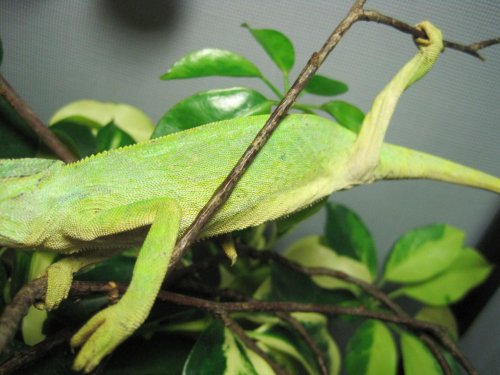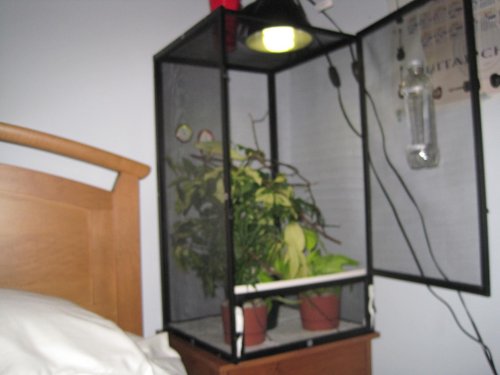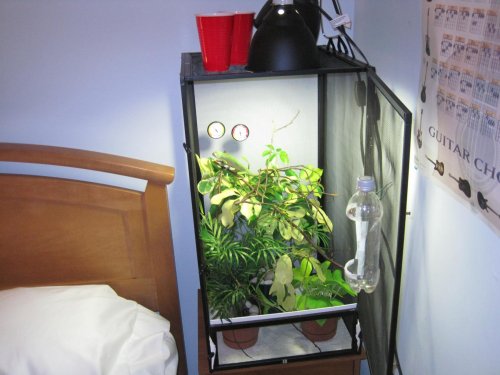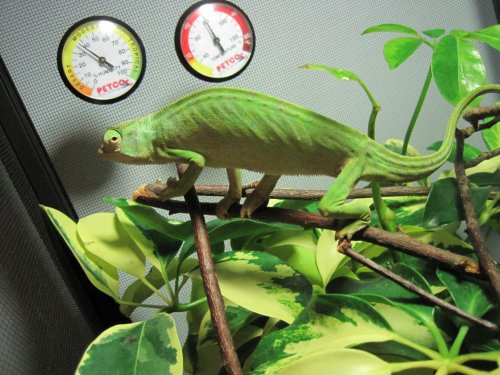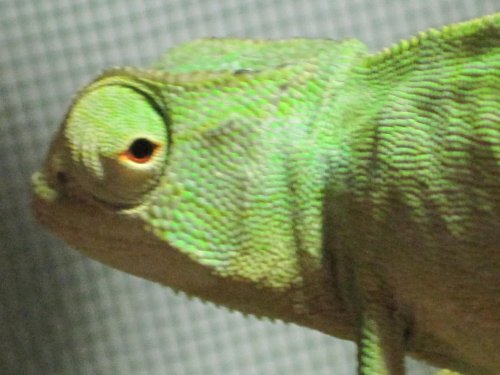Jeremiah
New Member
Chameleon Info:
Your Chameleon - Chamaeleo Senegalensis, male, age unknown, it has been in my care for about 3 weeks
Handling - once a week for cage cleaning.
Feeding - 1/4 to 1/2 inch crickets, four crickets are added to cricket cup daily, Saturday is the day of fast. Crickets are gut-loaded on Fluker's orange cube gut-load.
Supplements - Herptivite with beta carotene multivitamin and Reptivite calcium with D3. once ever other week.
Watering - Hand misting through the the cage. 2-3 times daily for about 30 seconds each time. I have seen my Chameleon drink on multiple occasions.
Fecal Description - It is brown with a whitish-yellowish urate. I have only seen it dried on leaves. Apparently he was tested for parasites at the facility he was bought from.
History - I bought him from Big Apple Herp. He didn't eat for a few days after arriving. He came as a bit of a surprise because we were expected a juvenile chameleon so the company lied about that.
Cage Info:
Cage Type - Screen 16 by 16 by 30 zoomed reptibreeze
Lighting - I have a Exo Terra Repti-glo compact florescent 26 watt 5.0 uvb bulb in an exo terra 7 inch dome that is supposed to increase uvb output by "100%"
Temperature - I haven't measured the bottom of the cage however the top through mid portions are about 80 F during the day and drop down to 75 F at night. I have measured these using the ever so simplistic analog Thermometer (I know it's bad)
Humidity - humidity ranges from about 40% to 60% this is created my manual misting. I measure this through an analog hydrometer.
Plants - I have an Umbrella tree, Neathe Bella Palm ( Chamaedorea elegans) and a pothos.
Placement - It is in the corner of my bed room. It is secluded with the door closed during the day. The top of the cage is about 4 and a half to 5 feet off the floor.
Location - I am geographically located in Northern Maryland.
Current Problem - My chameleon the dude is becoming quite thin with his ribs showing through his body. He was about 29 grams when I first got him and was 25 grams when he was measured today.
Your Chameleon - Chamaeleo Senegalensis, male, age unknown, it has been in my care for about 3 weeks
Handling - once a week for cage cleaning.
Feeding - 1/4 to 1/2 inch crickets, four crickets are added to cricket cup daily, Saturday is the day of fast. Crickets are gut-loaded on Fluker's orange cube gut-load.
Supplements - Herptivite with beta carotene multivitamin and Reptivite calcium with D3. once ever other week.
Watering - Hand misting through the the cage. 2-3 times daily for about 30 seconds each time. I have seen my Chameleon drink on multiple occasions.
Fecal Description - It is brown with a whitish-yellowish urate. I have only seen it dried on leaves. Apparently he was tested for parasites at the facility he was bought from.
History - I bought him from Big Apple Herp. He didn't eat for a few days after arriving. He came as a bit of a surprise because we were expected a juvenile chameleon so the company lied about that.
Cage Info:
Cage Type - Screen 16 by 16 by 30 zoomed reptibreeze
Lighting - I have a Exo Terra Repti-glo compact florescent 26 watt 5.0 uvb bulb in an exo terra 7 inch dome that is supposed to increase uvb output by "100%"
Temperature - I haven't measured the bottom of the cage however the top through mid portions are about 80 F during the day and drop down to 75 F at night. I have measured these using the ever so simplistic analog Thermometer (I know it's bad)
Humidity - humidity ranges from about 40% to 60% this is created my manual misting. I measure this through an analog hydrometer.
Plants - I have an Umbrella tree, Neathe Bella Palm ( Chamaedorea elegans) and a pothos.
Placement - It is in the corner of my bed room. It is secluded with the door closed during the day. The top of the cage is about 4 and a half to 5 feet off the floor.
Location - I am geographically located in Northern Maryland.
Current Problem - My chameleon the dude is becoming quite thin with his ribs showing through his body. He was about 29 grams when I first got him and was 25 grams when he was measured today.


